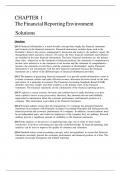Exam (elaborations)
Solution manual for intermediate accounting 3rd edition elizabeth a gordon jana s raedy alexander j sannella_compressed
- Course
- Institution
Solution manual for intermediate accounting 3rd edition elizabeth a gordon jana s raedy alexander j sannella_compressedSolution manual for intermediate accounting 3rd edition elizabeth a gordon jana s raedy alexander j sannella_compressedSolution manual for intermediate accounting 3rd edition eliza...
[Show more]



